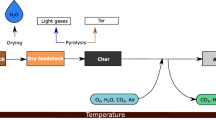Abstract
Recycling of various wastes such as sewage sludge requires an energy conversion process like thermal pyrolysis/gasification. During the process, tar and syngas are produced, but the tar brings trouble in pipelines and creates operating problems for the facility. In this study, to investigate naphthalene destruction in a gliding arc plasma reformer, parametric experiments were achieved in the variables that can affect the destruction efficiency. And through the parametric studies, the optimal operating conditions and the results were taken. For the parametric studies, steam input amount (steam/carbon ratio), input discharged power SEI (specific energy input), total feed gas amount, input naphthalene concentration, and electrode length were selected for experiments. Optimal conditions were 2.5 of S/C ratio, 1 kWh/m3 of SEI, 18.4 L/min of total gas amount, 1% of input naphthalene concentration, and 95 mm of electrode length. The corresponding maximum destruction efficiency of naphthalene was 79%, and energy efficiency showed 47 g/kWh.
Similar content being viewed by others
References
L. Devi, K. J. Ptasinski and F. J. J.G. Janssen, Fuel Processing Technol., 86, 707 (2005).
H. Zhao, D. J. Draelants and G.V. Baron, Ind. Eng. Chem. Res., 39, 3195 (2000).
L. Devi, K. L. Ptasinski and F. J. J.G. Janssen, Ind. Eng. Chem. Res., 44, 9096 (2005).
Y. N. Chun and H. O. Song, Environ. Eng. Sci., 23, 1010 (2006).
A. J. M. Pemen, S. A. Nair, K. Yan, E. J. M. van Heesch, K. J. Ptasinski and A. A. H. Drinkenburg, Plasmas and Polymers, 8, 209 (2003).
Z. L. Wu, X. Gao, Z.Y. Luo, M. J. Ni and K. F. Cen, J. Environ. Sci., 16, 543 (2004).
Y. F. Guo, D. Q. Ye, D. F. Chen, J. C. He and W. L. Chen, J. Mol. Catal. A:Chem., 245, 93 (2006).
C. M. Du, J. J. Yan and B. Cheron, Plasma Sources Sci. Technol., 16, 791 (2007).
Y. N. Chun and H. O. Song, Energy Sources, 30, 1202 (2008).
A. Indarto, J.W. Choi, H. Lee and H. K. Song, Energy, 31, 2986 (2006).
R. Burlica, M. J. Kirkpatrick, W. C. Finney, R. J. Clark and B. R. Locke, J. Electrostatics, 62, 309 (2004).
T. Sreethawong, P. Thankonpatthanakun and S. Chavadej, Int. J. Hydrogen Energy, 32, 1067 (2007).
L. Yu, J. H. Yan, X. D. Li, X. Tu, S.Y. Lu, M. J. Ni, Y. Chi and K. F. Cen, International Symposium on Plasma Chemistry, 19th International symposium on plasma chemistry Bochum, July 26 to 31 (2009).
Z. Bo, J. Yan, X. Li, Y. Chi and K. F. Cen, J. Hazard. Mater., 155, 494 (2008).
Author information
Authors and Affiliations
Corresponding author
Rights and permissions
About this article
Cite this article
Yang, Y.C., Chun, Y.N. Naphthalene destruction performance from tar model compound using a gliding arc plasma reformer. Korean J. Chem. Eng. 28, 539–543 (2011). https://doi.org/10.1007/s11814-010-0393-2
Received:
Accepted:
Published:
Issue Date:
DOI: https://doi.org/10.1007/s11814-010-0393-2




